Act one: BaselWorld 2007
Some thirty journalists from around the world are invited one by one to visit the stand of Maurice Lacroix, and enter into a small room that seems more like a futuristic space capsule. In the centre is a low table, seemingly innocuous in appearance. A film is then projected onto a flat screen on the wall, with the title: ‘Can a mechanism remember?’ This gives us some indication of the subject, but what follows only adds to the mystery. . . A type of billiard ball gathers momentum and slides, at great speed, along a rail hung in space where various images are floating. They represent the ‘different’ times of life. The ball partly opens, revealing its complex mechanical entrails. An arm reaches out from these metallic innards and, with a pair of tongs, snatches one of the floating images. The ball continues along its path and then deposits the image into what resembles a mechanical circle. Another ball arrives, equipped with an eye similar to a camera lens, takes a picture of the newly deposited image, and then speeds away. The balls begin to crisscross each other, passing one, overtaking the other, and capturing images. . .
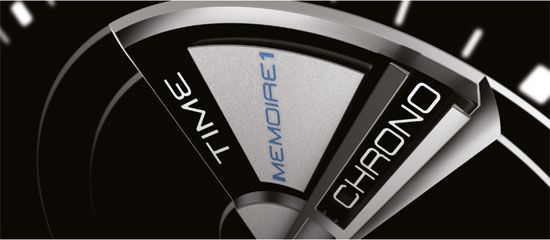
ACT ONE
The film ends and a glass case automatically rises from the low table. In the centre is a watch with an unexpected design. But hardly is there time to lean over and look more closely at it than the case disappears again back into the table. In front of us, Philippe Merk, the brand’s CEO, and Sandro Reginelli, Product Manager, smile enigmatically. Their responses to our questions are deliberately succinct. “Yes, a mechanism is capable of remembering and we are going to demonstrate it with our Mémoire 1.”
All that we learn, however, is that the mysterious timepiece is a chronograph that has only two hands—minutes and seconds—as well as an hour display on a disc. By pressing a pushbutton integrated into the crown, the watch can pass instantaneously from the time function to the chronograph function that measures the time intervals with the same two hands. Another press on the pushbutton, and the watch returns to the exact time indication, while leaving the chronograph still engaged. The chronograph continues to operate and the wearer can return to look at it at will.
Between these two modes, always displayed with the same hands, the memories of both of them are never lost. We won’t learn much more for the time being, and no details about this extravagant mechanism are given. Oh, except for one. It is composed of 537 component parts.
Act two: a movement that works backwards
We would have to wait many months to learn more, which again dribbled down in bits and pieces. The second act comes one or two months later. The mechanical ‘circle’ from the short film has become an automatic mechanical movement. But it is displayed so quickly that we still do not understand anything. A few additional explanations are nonetheless provided but, instead of answering our questions, they actually raise more.
We do learn that the movement, the Calibre ML 128, has been entirely created in-house by Maurice Lacroix. Surprisingly, however, it turns backwards from the barrel! An explanation: The spring is compressed on the barrel shaft as in a traditional movement but, in this new watch, it is compressed from right to left instead of from left to right. This means that the optimized system of gears, which transmit the driving power to the regulator, turn backwards, before finally delivering energy to the escapement. The ‘how’ is clear, but not the ‘why’ of having the movement work in reverse. The answer to this question will have to wait.
Still without seeing the overall watch, we learn a bit more about the technical and design details. The rotor is exocentric, small, and with an asymmetrical design. It is also made of a heavy material, tungsten. It pivots on a ball bearing specially developed for the calibre and is wound in both directions. This rotor works directly in the reverse, via a ‘magic pawl’ that optimizes the wrist movements of the wearer. Because of its small size, the rotor allows a good view of the inner organs of the Mémoire 1, which are decorated and coated with a PVD tantalum colour surface treatment.
One last detail, for aesthetic as well as technical reasons, the stones in the movement are white and transparent. Beyond being beautiful, this transparency allows the watchmaker to better check the gearing and to clearly see a small drop of oil as it is placed in the hollow section of the stone. To learn more, we have to wait for the third act.
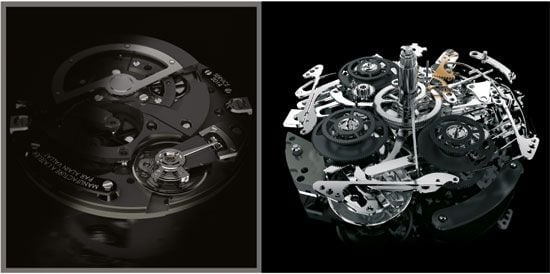
ACT TWO and ACT THREE
Act three: all or nothing
In September 2007, we receive a few new snippets of information. Maurice Lacroix clearly reaffirms its objective in creating this watch. In no case is this exploit about achieving a ‘technical coup’ but rather in ‘creating a masterpiece whose place will be assured in the future reference annals of the art of watchmaking.’
This determination clearly falls within the framework of a larger strategy to gradually move up-market, to achieve industrial verticalization, and to build the brand. The goal is to create a great brand that will be in the club of major brands in the future. With the MÉmoire 1, Maurice Lacroix is well on its way to fulfilling these ambitions.
A few more details come our way. The first is a system called ‘va et vient’ (‘come and go’) for which a patent has been filed. Thanks to a pushbutton integrated into the crown, the wearer can select between the two modes, either the time display or chronograph function. The mode is indicated by a hand, located at 3 o’clock on the dial. Starting, stopping, and resetting the chronograph to zero work in the same way as in traditional chronographs. In this case, the two pushbuttons are located at 2 o’clock and 4 o’clock.
There is also an additional device on the Mémoire 1, which uses the principle of ‘all or nothing’ for the minute repeater (in which the chime is activated only if the slide is fully armed). A device guarantees perfect functioning during the change of mode (time or chronograph), as well as assuring the pre-cision of the ‘memorized’ indications. When the ‘come and go’ mechanism is selected, the connecting ‘all or nothing’ mechanism activates the three systems of memory that correspond to the hours, minutes, and seconds.
So, how does all of this function? Since, we are told, this watch also has a date, whose indicator will be totally new and original, how does this work, and how will the date be displayed? Perhaps, we will learn more in the fourth act of this timely play.
Act four: shown in Shanghai
In Act Four, we are invited to Shanghai where the watch is finally unveiled. Why Shanghai, you ask? The answer comes from the elegant, brilliant, and creative event itself. Beyond the discovery of the watch, the brand’s message is clear: by organizing the event in the heart of one of the fastest growing metropolises in the world, Maurice Lacroix declares its intention to conquer new markets and new territories. But if the intent is obvious, the method is subtler. China’s ancestral and traditional heritage is juxtaposed with the innovative and avant-garde of the future.
For example, when returning from a trip to a village in the ‘Eternal China,’ we travel on the fastest magnetic train in the world. After visiting the construction site of what will become the highest building in Asia, we are transported in antique cars dating from the 1930s to a restaurant that was, during the time of the concessions, the Consulate of the United Kingdom. The presentation of the watch itself is preceded by a show that mixes old Chinese men and women doing Tai Chi with young urban acrobats. But isn’t this exactly the positioning that Maurice Lacroix is seeking—mastery of the art of timekeeping where care and attention to detail come from its long tradition, while being infused with a modernist spirit?
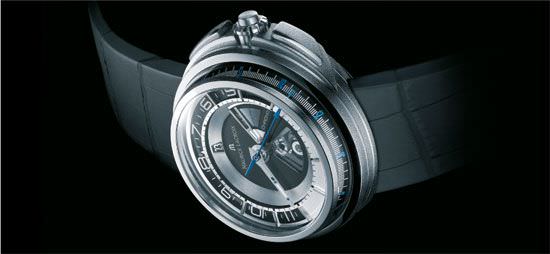
ACT FOUR
The curtain finally rises on the watch that we saw only a glimpse of six months earlier. As Sandro Reginelli describes, ‘everything in this watch evokes modernity, simplicity, and purity. This is its strength. While it is an extremely complicated piece, it seems very simple at first glance. It is not extravagant, but it is extraordinary. It is not interesting or attractive because of its size or the utilization of coloured materials, or even because of the addition of unnecessary technical or stylistic decorations. Everything is focused on the extreme ‘simplicity’ of its memory function. A Grand Complication should not necessarily have to look complicated.”
The white gold case is constructed on several levels. One of the first things you notice is the angled seconds hand that travels around the dial, above the timer placed in a lateral band around the side of the case. The dial itself is divided into different levels. On the outer portion of the dial rotates the transparent hour disc, which is made of a material uncommon in watchmaking. It is a mineral glass whose density is greater than sapphire crystal. The next circle slopes downward. The position of the date disc allows the date to be immediately seen.
The central dial, with its minute and seconds hands, features a window that shows the selected mode. At 6 o’clock, an opening lets the upper part of the mechanism of the ‘second memory’ be seen. The crocodile leather strap is entirely integrated into the case using a system of hinges. The finishing is amazing, and delicately alternates between areas that are polished like a mirror, satiny, sanded, or microbillÉe. We are definitely impressed, but we still must wait to learn exactly how all of this works!
Act five: BaselWorld 2008, the wait is over
Finally, things are becoming clearer. With its 537 component parts, the Mémoire 1 is the most complicated watch with ‘three hands’ in the world. Let’s review some of the main elements of the memory mechanism that is integrated into a movement that was, itself, specially developed for this timekeeper. (Its Swiss escapement was developed and adapted specifically for the special needs of this complication, while the finely adjustable transparent balance vibrates at 28,800 vibrations per hour.) See ACT FIVE above.
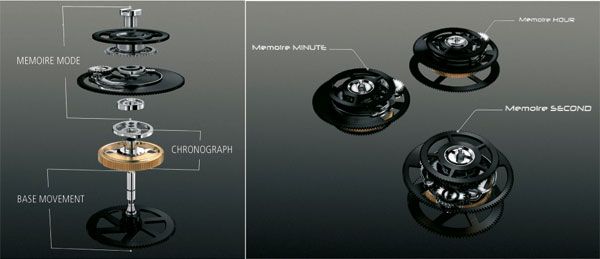
The three memory mechanisms
The Mémoire 1 has three memory mechanisms according to the type of display. The mechanism for the hours is at 12 o’clock, for the minutes at 9 o’clock, and for the seconds at 6 o’clock. The latter is visible through an opening in the lower part of the dial.
The three parts of the memory mechanism
Each memory mechanism is made up of three main devices. At the bottom is the carrier device that provides the connection between the movement and the complication. The second device is the ‘chronograph block’ with all the elements that assure the functioning of a traditional chronograph, including the coupling and the heart of the chronograph (which allows the chronograph to be reset). The third mechanism is the ‘modus block’ that consists of the memory heart ‘Chrono,’ an intermediate gear wheel with two hammer levers, the memory heart ‘Time,’ and the intermediate mobile carrier wheel.
An exceptionally complex system is responsible for the mechanical memory and the mode change. A hammer lever brings the information from either the ‘Time’ heart, showing the actual time, or from the ‘Chrono’ heart, providing the chronograph timing. When the upper lever (‘Time’) activates the ‘Time’ heart, the two levers are opposed to each other but separated by a mobile carrier wheel. The lower lever (‘Chrono’) then releases the ‘Chrono’ heart, and vice versa.
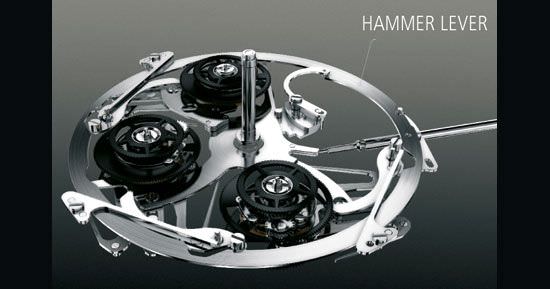
Start/stop function
The traditional column wheel that controls the chronograph functions (start/stop) has been replaced by a coupling lever. This lever acts directly on the chronograph pliers. When the ‘start’ function is activated, the coupling lever opens the chronograph pliers and releases its gear train so that the timing function can begin. When the chronograph is stopped, the operation takes place in reverse, and the chronograph gear train is blocked by the same pliers.
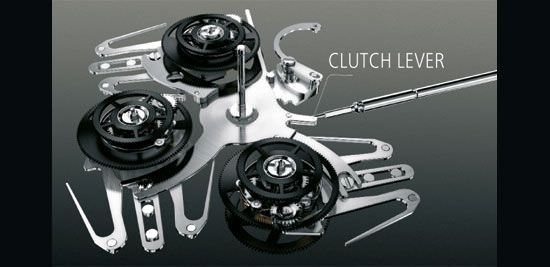
Resetting to zero
The hammer lever is responsible for resetting the chronograph to zero. Its form and the different pos-itions of the hammer control ring allow the chronograph cam to rise or fall against the chronograph heart, thus resetting the position to zero.
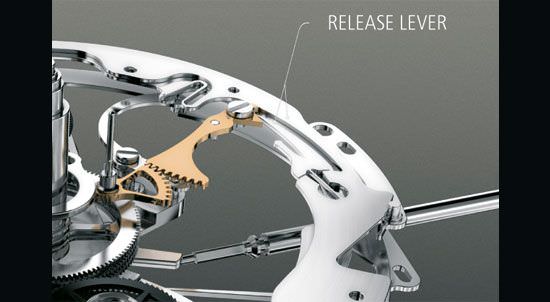
Controlling the mode change
The mode change is controlled by the release ring. During release, two rings activate the three memory mechanisms with the help of three locking cones, thus allowing the change between the two modes (time and chronograph) to happen. Besides the locking cones, the release ring integrates the ‘come and go’ and ‘all or nothing’ systems. The ‘come and go’ is a beak on the release spring that enables the display of the mode change. The ‘all or nothing’ is a safety system equipped with a spring that connects the locking ring cone to the release spring, causing the component parts to move along the entire path in order to guarantee a perfect mode change operation.
A collective adventure
Two years were required for the development of this magnificent idea, which was born in January 2006. It is indeed a very short time span when you consider the complexity of the system. The project was initiated by Philippe Merk who desired to make Maurice Lacroix “an incontestable watch manufacturer on the landscape of the large Swiss brands.” It was made possible thanks to a group that was formed, L'Atelier Maurice Lacroix, composed of experts in construction, engineering, and watchmakers both in-house and external to the brand.
Contrary to numerous brands that do not reveal collaboration with exterior contractors, Maurice Lacroix has not hesitated in affirming its external relationships, in all their transparency. Among them, two external partners have played an essential role in the Mémoire 1 — Les Artisans Horlogers, specialists in the creation and development of movements and complications, and the designers at the company White SA.
The question that was asked to the members of L'Atelier Maurice Lacroix was: How to obtain several indications while maintaining the most classical visual appearance and displays? “This question haunted the team during the entire creative process, right up to the day when one of the members of the Atelier made the following remark: ‘The chronograph is one of the main competencies of Maurice Lacroix so why not design a chronograph with only three hands?’ Or in other words, create a mechanical system for what can only be done today with quartz?”
Everything began with this suggestion. The result, as we see today, exceeds expec-tations. The Mémoire 1 is spectacular. It is also classic, pure, and technical yet whimsical. Its design is to provide pleasure and ease of utilization for the final client—a form of respect, from beginning to end of this wonderful adventure.
Source: Europa Star April-May 2008 Magazine Issue




